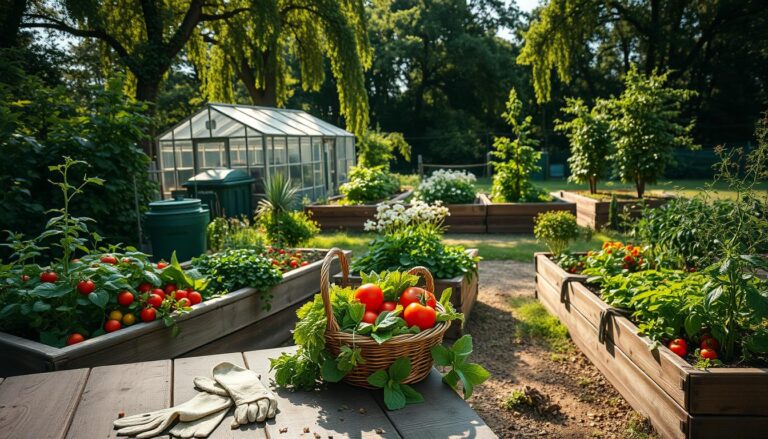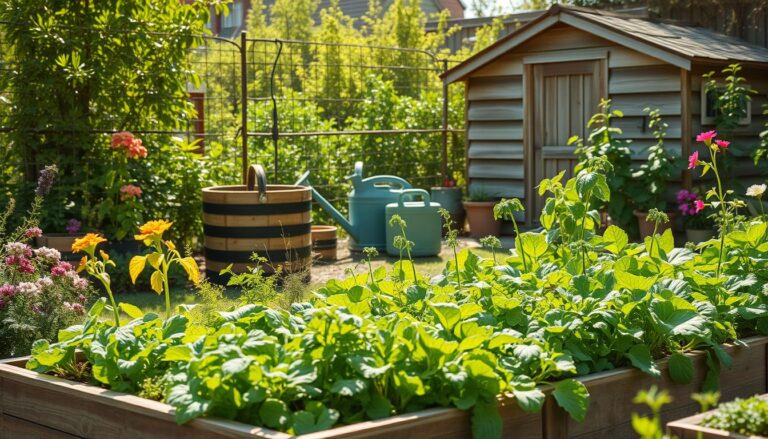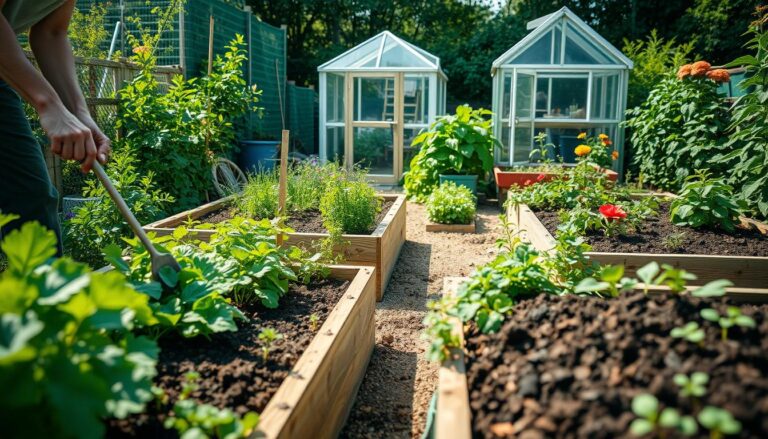Creating a lush, healthy garden is rewarding. It’s great for the environment too. By using eco-friendly gardening strategies, you can make a beautiful outdoor space. It’s good for you and the planet.
Using sustainable practices in your garden makes it more beautiful. It also helps the ecosystem. With the right organic gardening tips, your garden will be full of life.
Starting your organic gardening journey has many benefits. It improves soil health and reduces carbon footprint. You’ll create a haven for local wildlife and a peaceful retreat for years.
The Benefits of Organic Gardening
Organic gardening lets you create a lush, healthy garden. It’s good for the planet and for you. You use natural gardening techniques that don’t harm the environment.
Understanding Organic Gardening
Organic gardening focuses on sustainable gardening practices. It aims to improve soil health and support biodiversity. It’s about making a space where plants and animals can live well together.
Environmental Impacts
Organic gardening is great for the environment. It cuts down on pollution and saves water. It also helps keep our food free from harmful chemicals.
Health Advantages
Organic gardening is good for your health too. Eating food grown without harmful chemicals is safer. Gardening also keeps you active, which is good for your overall health.
Selecting the Right Location for Your Garden
Finding the perfect spot for your garden is key to a healthy, organic garden. The right spot can make a big difference in your garden’s health and how well it grows. This is especially true when you’re using chemical-free gardening methods.
Sunlight Requirements
Most plants need enough sunlight to grow. Make sure the spot you choose gets the right amount of sun for your plants.
- Vegetables and fruits need full sun (6-8 hours of direct sunlight).
- Some plants, like leafy greens, can handle partial shade.
To figure out how much sun your garden gets, watch it throughout the day. You can also use a sunlight tracker or just observe the area at different times.
Soil Drainage Considerations
Soil drainage is very important. Poor drainage can make the soil waterlogged, which is bad for plants. To check drainage, do a simple water test:
- Dig a hole about 12 inches deep.
- Fill it with water and let it drain.
- Refill the hole and see how long it takes to drain again.
If the water drains in 1-2 hours, your soil drains well.
| Drainage Type | Drainage Time | Implications |
|---|---|---|
| Good Drainage | 1-2 hours | Suitable for most plants |
| Poor Drainage | More than 4 hours | May need soil changes |
Proximity to Water Sources
Having water nearby is crucial for your garden. Rainwater harvesting is a smart green gardening tip. It saves water and cuts down on using city water.
“The best fertilizer for your garden is the gardener’s shadow.” –
This saying shows how important regular care is. Being close to water makes caring for your garden easier.
Choosing Organic Seeds and Plants
For gardeners who want to garden in an earth-friendly way, picking the right seeds and plants is key. This choice sets the stage for a healthy organic garden.
It’s important to know the different types of seeds and plants and their benefits. This knowledge helps create a garden that is diverse and strong.
Heirloom vs. Hybrid Varieties
Choosing between heirloom and hybrid varieties is a big decision. Heirloom varieties can be saved and replanted year after year, keeping their special traits. Hybrid varieties are made for specific traits like disease resistance but may not save well.
Gardening expert says,
“Heirloom varieties offer a genetic diversity that is invaluable for the future of gardening.”
This diversity is great for gardeners who want a garden that can adapt and stay strong.
Local vs. Exotic Plants
Deciding between local and exotic plants is also important. Local plants fit well with the local climate and soil, needing less care. Exotic plants can add new things to your garden but need more attention and specific conditions.
Many gardeners are choosing local plants for their hardiness and ease of care. This choice fits well with organic gardening tips that encourage working with nature.
Seasonal Planting Tips
Knowing when to plant is key for a successful organic garden. Seasonal planting tips help you use your garden all year. For example, cool-season crops like broccoli and kale do well in early spring or late summer.
- Plan your garden calendar around the last frost date for your area.
- Choose varieties that are suitable for your local climate and growing season.
- Consider succession planting to ensure a continuous harvest.
By following these earth-friendly gardening tips and keeping an eye on the seasonal planting schedule, you can have a garden full of variety and abundance.
Soil Health: The Foundation of Organic Gardening
Organic gardening starts with the soil. A balanced ecosystem here supports healthy plants and biodiversity. Keeping your soil healthy is key to a successful garden.
Testing Your Soil
Knowing your soil’s makeup is the first step to better health. Soil testing shows its pH, nutrients, and structure. There are many ways to test your soil.
- Use a DIY soil testing kit for a quick check.
- Send a sample to a lab for detailed results.
- Look at the soil’s texture and color to judge its health.
Amending Your Soil Organically
After knowing your soil’s condition, you can start making it better. Adding organic matter like compost or manure boosts soil health. Here’s how to do it:
- Add compost to increase nutrient levels.
- Use well-rotted manure for better soil fertility.
- Plant cover crops to add organic matter and stop erosion.
Natural Fertilizers to Consider
Natural fertilizers give plants the nutrients they need without harming the environment. Fish emulsion, alfalfa meal, and green sand are good choices.
- Fish emulsion for a nitrogen boost.
- Alfalfa meal for nitrogen and other nutrients.
- Green sand to improve soil structure and add micronutrients.
Effective Pest Management Strategies
Effective pest management is key to successful organic gardening. It keeps the ecosystem balanced. Organic gardeners face the challenge of controlling pests without synthetic chemicals. These chemicals can harm the environment and contaminate soil and water.
Companion Planting Techniques
Companion planting is a simple and effective pest control method. It involves growing different plants together to deter pests or attract beneficial insects. For example, marigolds repel nematodes, while basil repels aphids. By planting certain species together, gardeners can naturally reduce pest pressure.
- Plant marigolds with tomatoes to deter nematodes.
- Grow basil near aphid-prone plants to keep them pest-free.
- Use nasturtiums to repel aphids, whiteflies, and other pests.
Beneficial Insects
Beneficial insects are a gardener’s best friend for pest control. Ladybugs and lacewings are natural predators of common garden pests like aphids and mites. To attract these beneficial insects, plant a diverse range of flowers that provide nectar and pollen, such as dill, fennel, and cosmos.
- Attract ladybugs by planting marigolds and dill.
- Create a welcoming environment for lacewings with angelica and cosmos.
Organic Pest Control Products
When pest infestations become severe, organic gardeners can use natural pest control products. Neem oil is a versatile option that controls a wide range of pests, from aphids to spider mites. Other products like insecticidal soap and diatomaceous earth offer targeted solutions for specific pest problems.
- Use neem oil to control aphids, whiteflies, and spider mites.
- Apply insecticidal soap directly to pests for immediate control.
- Dust plants with diatomaceous earth to dehydrate and kill pests.
By combining companion planting, encouraging beneficial insects, and using organic pest control products, gardeners can maintain a healthy ecosystem. This holistic approach protects the garden and supports sustainable gardening practices.
Watering Wisely: Techniques for Success
Watering an organic garden right is all about finding the right balance. You need to give your plants enough moisture without wasting water. This balance is key to keeping your garden healthy and productive.
Best Watering Practices
Understanding what your plants need is crucial. Different plants require different amounts of water. Soil type, climate, and the time of day also play a big role.
- Water your plants in the early morning or late evening to minimize evaporation.
- Use soaker hoses or drip irrigation to deliver water directly to the roots, reducing runoff and waste.
- Avoid overhead watering, which can lead to fungal diseases and wasted water.
Using Mulch to Retain Moisture
Mulching is a simple yet effective way to keep soil moist. By adding a layer of organic mulch around your plants, you can cut down on how often you need to water.
Benefits of Mulching:
| Benefit | Description |
|---|---|
| Moisture Retention | Mulch keeps the soil cool and moist, reducing the need for frequent watering. |
| Weed Suppression | A layer of mulch can suppress weed growth, reducing competition for water and nutrients. |
| Soil Health | As mulch breaks down, it adds organic matter to the soil, improving its structure and fertility. |
Rainwater Harvesting Tips
Harvesting rainwater is an earth-friendly gardening tip that saves water and reduces reliance on municipal supplies. Here are some tips for effective rainwater harvesting:
- Install a rainwater harvesting system that includes a collection tank and a distribution mechanism.
- Use a first flush device to divert the initial flow of water from the roof, taking any debris with it and keeping your tank cleaner.
- Ensure your collection tank is covered to prevent mosquito breeding and contamination.
By using these watering techniques, your organic garden can thrive while being kind to the environment. Every drop counts, and these green gardening advice practices help make a sustainable future closer.
Organic Weed Control Methods
Managing weeds is key to a successful organic garden. Weeds steal water, nutrients, and sunlight from your plants. This can harm the plants you want to grow.
Hand Weeding Techniques
Hand weeding is a simple yet effective way to control weeds. You can pull them out or use tools like hoes. It’s best to weed after a rain when the soil is moist.
Tips for Effective Hand Weeding:
- Remove weeds when they are young to prevent them from spreading seeds.
- Use a hoe or cultivator to loosen the soil around the weeds before pulling.
- Ensure you remove the entire root system to prevent regrowth.
Mulching for Weed Prevention
Mulching is another great way to keep weeds away. Organic mulch like wood chips or straw blocks light and prevents seeds from germinating. It also keeps the soil moist and regulates its temperature.
Benefits of Mulching:
- Reduces the need for frequent weeding.
- Conserves soil moisture.
- Enhances soil health as it breaks down.
Natural Herbicides to Use
Natural herbicides are good for tough weed problems. Vinegar-based herbicides kill weeds by spraying them directly. You can also use boiling water or soap-based herbicides.
Precautions When Using Natural Herbicides:
- Always spot test to ensure the herbicide doesn’t harm desired plants.
- Apply directly to the weeds to minimize overspray.
- Consider the environmental impact of the chosen herbicide.
Using these organic weed control methods can keep your garden healthy and weed-free. You won’t need chemical herbicides.
Crop Rotation and Plant Diversity
Crop rotation and plant diversity are key for a healthy garden. They help keep the soil in good shape and make gardening more eco-friendly. By changing crops and using different plants, gardens become better at fighting pests and diseases.
The Importance of Crop Rotation
Crop rotation is a key part of gardening the right way. It means changing what you grow in a certain spot over time. This keeps the soil rich, fights pests and diseases, and makes crops grow better.
Benefits of Crop Rotation:
- Improves soil health and fertility
- Reduces the risk of pests and diseases
- Enhances biodiversity
- Increases crop yields
Selecting Diverse Plant Varieties
Choosing a variety of plants is vital for a thriving garden. Different plants need different things and grow in different ways. This keeps the soil healthy and cuts down on the need for chemicals.
Tips for Selecting Diverse Plant Varieties:
- Choose plants that are right for your climate and soil
- Use a mix of annuals and perennials
- Look for plants that attract good bugs
Managing Plant Families
It’s important to manage different plant families well. This means knowing what each family needs and how they grow. By grouping similar plants together, gardening gets easier.
Using crop rotation and plant diversity makes gardening better for the planet. It improves the soil, boosts biodiversity, and makes gardens stronger and more resilient.
Maintaining Your Organic Garden Year-Round
Organic gardening is a year-round job. It means changing with the seasons using the right methods and tools. This keeps your garden healthy, productive, and free from chemicals.
Seasonal Garden Tasks
Spring is for getting your soil ready with compost or manure. Summer is when you water, mulch, and watch for pests. Autumn is for harvesting and cleaning up. Winter is for planning, pruning, and soil protection.
Knowing these tasks is key to a balanced garden. For example, planning crop rotation in winter keeps soil healthy and pest-free.
Tools for Organic Gardening
Having the right tools is crucial for organic gardening. You’ll need a garden fork, hoe, and pruning shears. These tools may cost more but are worth it in the long run.
Tools like rain barrels and drip irrigation systems also help. They save water and follow green gardening advice.
| Tool | Purpose | Benefits |
|---|---|---|
| Garden Fork | Turning over soil, aerating | Improves soil structure, enhances root growth |
| Hoe | Weeding | Reduces weed competition, minimizes soil disturbance |
| Pruning Shears | Pruning plants | Promotes healthy plant growth, encourages fruiting |
Cleaning and Storage of Gardening Tools
Keeping gardening tools in good shape is important. Clean them after each use to prevent disease. Store them in a dry place to make them last longer.
Sharpening and oiling tools prevents rust. This keeps them working well and supports sustainable gardening by reducing waste.
Resources for Organic Gardening Success
Looking to learn more about organic gardening? There are many resources out there. They can help you get tips on gardening the earth-friendly way.
Recommended Reading and Online Resources
Books and websites are full of guides on organic gardening. Start with “The Organic Gardening” magazine and “The New Organic Grower” by Eliot Coleman. The USDA’s National Organic Program website is also a great source of info.
Local Gardening Communities
Joining local gardening clubs is a smart move. They share tips and experiences. Plus, you can learn from others and get involved in events.
Online Forums for Organic Gardeners
Online forums like the Organic Gardening Forum are perfect for connecting. You can ask questions and share your gardening journey. It’s a great way to learn and stay updated.
FAQ
What are the key principles of organic gardening?
How can I improve the soil health in my organic garden?
What are some effective eco-friendly gardening strategies for pest control?
How often should I water my organic garden?
What are some sustainable gardening practices for reducing waste?
How can I maintain plant diversity in my organic garden?
What are some natural gardening techniques for weed control?
How can I harvest rainwater for my organic garden?
What are some chemical-free gardening methods for managing diseases?
Where can I find resources and support for organic gardening?

Sortemdia nasceu com o propósito de trazer alegria e oportunidades para todos por meio de sorteios gratuitos de prêmios incríveis. O site tem como missão oferecer experiências acessíveis, divertidas e justas para quem deseja concorrer a produtos, serviços e brindes sem pagar nada por isso. Acreditamos que a sorte pode bater à porta de qualquer pessoa — e no Sortemdia, ela pode chegar com apenas um clique.



